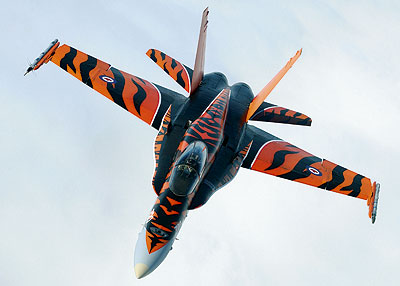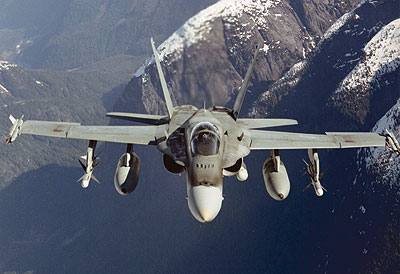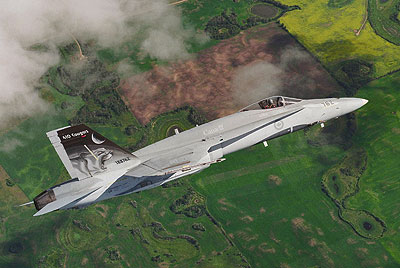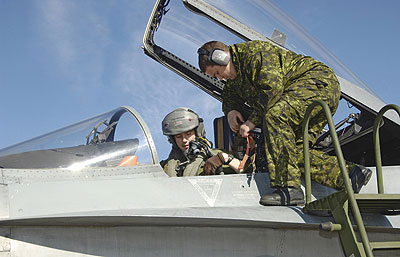 This information has been archived for reference or research purposes.
This information has been archived for reference or research purposes.
Archived Content
Information identified as archived on the Web is for reference, research or recordkeeping purposes. It has not been altered or updated after the date of archiving. Web pages that are archived on the Web are not subject to the Government of Canada Web Standards. As per the Communications Policy of the Government of Canada, you can request alternate formats on the "Contact Us" page.
Modern Warfare and Technological Development

DND photo CK2003-0361-05D
Stretching the Thin Blue Line:
Over-tasking the CF-18 Hornet
For more information on accessing this file, please visit our help page.
The concentration of limited financial and other resources on extending the life expectancy of the CF-18 may not accomplish what is required by present Canadian air defence policy.
The Cornerstone of Canadian Air Defence
Since 1982, the CF-18 Hornet has been the cornerstone of Canadian air sovereignty and air defence. Initially purchased with a 20-year expected life span, the subsequent extension of the CF-18’s life expectancy until 2017 requires extensive concentration of scarce resources on a single airframe that may not accomplish what it was intended to do. To understand this conclusion, one needs to trace the air defence policies reflected in Defence White Papers from 1971 onwards.
The 1971 White Paper provided clear national aims and policy themes on national defence. The national aim that had the most direct impact on national defence stated that Canada was to continue to be secure as an independent political entity. To accomplish this aim, several policy themes were also provided. The ones directly applicable to national defence were to “safeguard sovereignty and independence, work for peace and security and promote social justice.”1
The nuclear balance between the US and USSR, combined with the Cold War policy of Mutually Assured Destruction (MAD), obviously had an effect upon Canadian defence policy as it was set out in the 1971 White Paper. In addition, despite improved East/West relations, the prospects for effective international peacekeeping that were viewed with some optimism in the 1964 White Paper had not developed to the extent originally visualized. As a result, the defence and security of Canada and national sovereignty continued to be a top priority. Until the future deployment of the CF-18 in 1982, multi-layers of fighter aircraft addressed Canadian air sovereignty. These included CF-5s for non-nuclear air-to-surface tactical support of land forces, CF-101 Voodoos for long-range interceptions and identifications, and CF104s for supple mentary air defence duties, primarily in Canada’s prairie region.2
Sixteen years later, in 1987’s “A Defence Policy for Canada,” the government again provided clear and concise guidance for the Canadian Forces (CF). The 1987 policy was based upon two main premises for defence. The first was to provide a modern and realistic mandate to the CF and commit the government to giving its armed forces the tools to do the job. The second was once again to ensure a sovereign and free Canada.3 Although Canada’s overriding defence objective was still the prevention of nuclear war, it was believed that if war was unavoidable, Canada would assist in halting this war before it could escalate and threaten Canadian security.
However, the Canadian government realized that Canada could not alone assure its own security, and Canadian security thus depended upon the maintenance of a peaceful international order. To this end, Canada would continue to maintain forces in Europe, as it had since the early days of the Cold War, thus earning a say in key European security issues contributing to the defence of Canada. The government would leave 44 CF-18s in Europe for this role. However, maintaining Canadian sovereignty was also one of the government’s primary aims. To accomplish this, they would retain 60 CF-18s in Canada, supported by 58 CF-5s for homeland protection. The CF-5s would primarily be employed as trainers and for photographic reconnaissance, but, should the need arise, they could be brought to bear in a limited air-to-surface role. Canada’s sovereignty and security were thus considered intact for the period.

DND photo CX2005-0096-142a
A 441 Squadron CF-18 Hornet aircraft from Cold Lake, Alberta, flying over the mountains of British Columbia.
The End of the Cold War and the 1994 White Paper
Moving forward to the 1994 White Paper, one sees that this policy initiative was based upon the philosophy that the Cold War was over. Moreover, with the implosion of the USSR and the concomitant break-up of the Warsaw Pact, the threat of nuclear annihilation from this source was considered a thing of the past. The new threats were felt to exist in pockets of chaos and instability that threatened international peace and security. To this end, the government stated that Canada must remain an active participant in multilateral efforts to promote collective security.
“The Government concluded that to maintain Canada’s sovereignty and interests worldwide, the maintenance of multi-purpose, combat capable forces was in the national interest.”4 However, Canada did not and would not possess every component of military capability. As a result of this policy and the belief that all military capabilities were not required, a change in the structure of Canadian air defence took place. The remaining CF-5s were soon to be phased out, and the North Warning System effectively was placed in a form of inactive, warm storage. Instead of a layered approach to air defence, there would now basically be just a somewhat ‘thinner blue line’ of CF-18s.
However, the government further stated that sovereignty was a vital attribute of a nation state. Any attempt to dismantle the capacity to defend our country would be a grave mistake. The CF would monitor and control activity within Canada’s territory, airspace, and maritime area of jurisdiction. Further, Canada’s role in NORAD would be expanded to include counter- narcotics monitoring and surveillance, while simultaneously maintaining the capability to deploy a quick reaction fighter force complete with support personnel and equipment on short notice. This force would have the support required to remain in position until the designated crisis was over.
This multitude of tasks would be accomplished in spite of the fact that CF manning levels were to be reduced to 60,000 Regular Force personnel by 1999. The fighter force, the backbone of air defence and sovereignty, was to be reduced to a single aircraft type totalling no more than 80 CF-18s. The flying rate was to be reduced, and a 25 percent reduction in expenditures would be realized to meet the new fiscal restrictions governing CF operations. Despite these mandated reductions, the multi-role CF-18 was to have its air-to-surface role enhanced, and fighters with support personnel would still be committed to the United Nations and to the NATO alliance.

DND photo CKC95-5007
Current Canadian Air Defence Policy
With no updated Defence White Paper since 1994, current defence policy relies on a multitude of smaller documents that are continually being modified. The main documents being used to develop these supporting directives, however, are based on A Strategy for 2020, published in June 1999. In addition, Canadian Forces and government leaders have also published augmenting documents, such as Strategic Vectors, by the Chief of the Air Staff (CAS), and the Annual Report of the Chief of the Defence Staff 2003-2004.
The government currently believes that although Canada faces no direct conventional military threat, situations around the world are becoming more and more complex and unpredictable. Military response may be required for direct and indirect threats to our national security, such as drug trafficking, organized crime, illegal immigration and terrorism. As a result of this perceived change in threat, defence planning is now based upon what is required to protect and promote Canada’s interests and values in a responsive manner, rather than upon direct threats to our well-being.
As a review of the White Papers and other documents on defence policy indicates, clearly the underlying aim – the defence of Canadian sovereignty and security – has not changed. What has changed is how the Canadian Forces will enact this policy, and what equipment the nation will possess to accomplish the mandate. More specifically, how will these demands affect our fighter force?
To comprehend fully the impact that government policy has on the CF-18 fighter force, one must first understand the specific roles of fighter aircraft. In NORAD, the Canadian Forces are committed to provide fighters for air sovereignty and homeland security.5 In addition to this, Canada is committed to provide fighters to the United Nations and/or NATO at any given time, should the need arise.6 The CF-18 also has an air-to-surface role in support of the land forces. The first two roles are similar, but surface support is very different from air combat. These air-to-surface missions require additional training for the pilots, demand different weapons, and place a greater amount of structural fatigue upon the aircraft.
Since 1971, Canada has reduced the number of fighter aircraft in support of global security and homeland security, from over 200 units of multiple types, to less than 80 of a single type, the CF-18 Hornet. At first glance, one would think this should not be a problem with 80 fighters. Yet of these 80 fighters, only 60 are available for mission support at any given time. Twenty CF-18s are assigned to training or testing roles for the air force, and they are not mission ready on a regular and routine basis. When originally purchased, the CF-18 had a serviceability rate of 80 percent. Since it has passed its original 20-year life expectancy, there are problems arising that normally would not have been encountered in a projected service life. These problems often require parts that need to have special assembly lines established to produce parts for an obsolete aircraft. In no small measure due to the age of Canada’s Hornet fleet, the current unclassified serviceability rate is a little more than 50 percent.7 Given this situation, Canada does not appear to always be able to meet its NORAD mandate, let alone the nation’s other commitments.
Canadian Air Defence in the 21st Century
The CF-18 was ‘state of the art’ technology when it was introduced in 1982, and it enjoyed a very high flying rate with minimal ‘down time’ for maintenance. However, as the years have unfolded, the CF-18 has naturally aged and its technology soon became dated. The solution to this problem was to upgrade Canada’s remaining 80 fighters with new avionics, communications systems and radar. This upgrade will cost C$2.1 billion over the next six years in order to extend the operational life of the CF-18 until 2017.8 The upgrading of our CF-18s will allow them to operate with other air forces in joint operations. Unfortunately, this upgrade does not fully address the airframe fatigue that is occurring on an aircraft initially intended for retirement in 2002.
Canada is now spending considerably more money on the CF-18 when it is deployed than when it was new. As the airframe gets older, more repairs are required, and our operational tempo requires a substantial increase in spare parts that must be transported to theatre when the aircraft are deployed. While we are spending a lot of money on a single layer of air defence, we may not have enough fighter resources to achieve the overall defence objectives that the current policy papers have established.
This reminds one of a story in the history of military technology, in which defence policy did not match the availability of resources. With the development of siege artillery in the 15th Century, the ability of fortifications to repel attackers was greatly reduced. In an effort to re-establish this balance, the design and construction of fortifications had to change and to adapt. By the 16th Century, a fortress emerged that was impregnable by siege artillery. The Trace Italienne (Star Fortress) was the name of this engineering marvel.
The Trace Italienne was so successful that it spread rapidly through the city-states of Europe. The only downfall of these new fortifications was their cost. Papal Rome planned a belt of 18 Star Bastions, but gave up after spending more than 44,000 ducats on just one of them.9 It did provide an answer to siege artillery, but, unfortunately, no one was able to afford this defensive system. As a result, warfare for the next 300 years focused upon the offensive and remained so focused, until the trenches, barbed wire and machine guns of the Great War further revolutionized conventional warfare.
The CF-18 is a very capable aircraft. In fact, this writer believes the CF-18 is an excellent aircraft flown by some of the best pilots in the world. There is a limit, however, to what can be accomplished with older equipment, no matter how much money one invests in it downstream. Canada is, in my view, at that point with the CF-18. The nation is spending too much of its defence budget on an aircraft that, at the moment, is unable to support the nation’s entire fighter force commitments. Canada has also surrendered the concept of multi-layered air defence for a ‘thin blue line’ of CF-18s. And this ‘thin blue line’ has become stretched to the limit.
In future defence policies, Canada needs to ensure that its doctrine and resources work together to guarantee Canadian sovereignty and security. This may mean returning once more to a layered air defence appropriate to the threats and challenges of potential conflicts in the 21st Century.
![]()
Maj Ed Roberds, an Air Weapons Controller, is currently part of the A3 Exercise Coordination Cell at 1 Canadian Air Division Headquarters.
Notes
- 1971 White Paper “Defence as Part of National Policy.” Donald S. Macdonald, Minister of National Defence, August 1971. Douglas L. Bland, Canada’s National Defence, Volume 1 Defence Policy, (Kingston: School of Policy Studies, Queen’s University, 1997), p. 132.
- Ibid., pp. 148-149.
- Opening comments in 1987’s “Challenge and Commitment – A Defence Policy for Canada.” Perrin Beatty, Minister of National Defence, June 1987. Douglas L. Bland, Canada’s National Defence, Volume 1 Defence Policy (Kingston: School of Policy Studies, Queen’s University, 1997), p.193.
- 1994 Defence White Paper. David Collenette, Minister of National Defence. Douglas L Bland, Canada’s National Defence, Volume 1 Defence Policy (Kingston: School of Policy Studies, Queen’s University, 1997), p. 311.
- Various unclassified briefings conducted at 1 Canadian Air Division Headquarters – Winnipeg, Manitoba.
- Comments made by Major-General Bouchard, Commander 1 Canadian Air Division, to the Standing Committee on National Defence, Winnipeg, Manitoba, 11 March 2005.
- Various discussions with past CF-18 maintenance officers from the Aerospace Engineering and Test Establishment (AETE) and from 410 and 416 Squadrons.
- Extension of CF-18’s life expectancy briefed by Chief of the Air Staff to personnel at 17 Wing Winnipeg, 2003.
- Bert S. Hall, Weapons & Warfare in Renaissance Europe (Baltimore: The Johns Hopkins University Press, 1997), p. 162.

DND photo IS2006-1121by Sergeant Roxanne Clowe, Canadian Forces Combat Camera
Private Bobby Boucher, an aircraft technician at 4 Wing Cold Lake, straps in Captain Billy Mitchell, a pilot with Bagotville-based 425 Squadron during Exercise Maple Flag.






